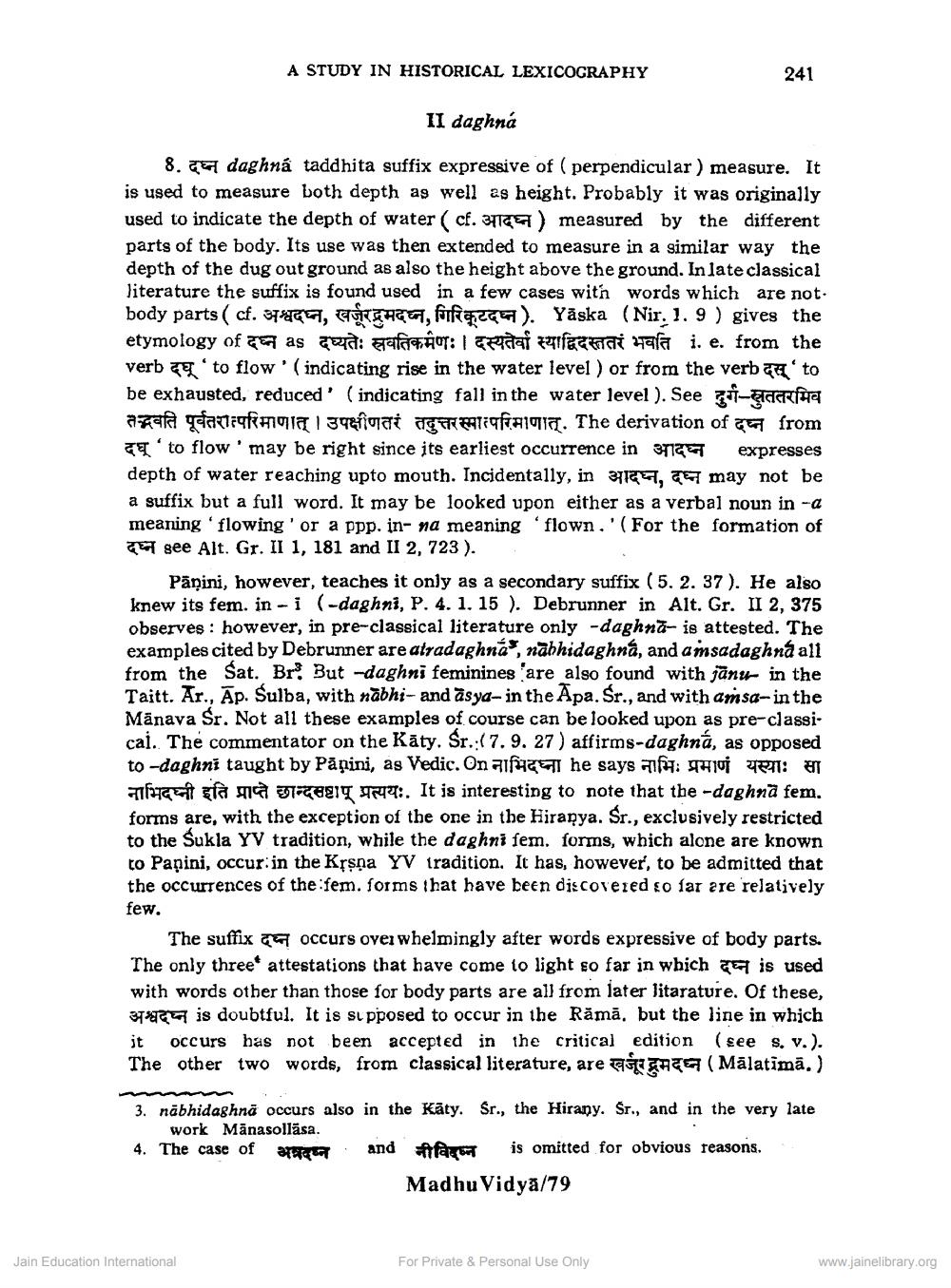________________
A STUDY IN HISTORICAL LEXICOGRAPHY
241
II daghna
8. El daghná taddhita suffix expressive of ( perpendicular) measure. It is used to measure both depth as well as height. Probably it was originally used to indicate the depth of water (cf. 371597) measured by the different parts of the body. Its use was then extended to measure in a similar way the depth of the dug out ground as also the height above the ground. In late classical literature the suffix is found used in a few cases with words which are not body parts of. STAGET, EREHTE, fotog). Yăska (Nir. 1. 9 ) gives the etymology of 76 as oa: gar : 1 graaf ES FA ala i. e. from the verb tren'to flow' (indicating rise in the water level ) or from the verb ac' to be exhausted, reduced' (indicating fall in the water level ). See ziedi azala gazteak #TOT I 3941vai UGT FAT1T. The derivation of a from TL'to flow' may be right since its earliest occurrence in 3717ET expresses depth of water reaching upto mouth. Incidentally, in 371997, TET may not be a suffix but a full word. It may be looked upon either as a verbal noun in -a meaning flowing' or a ppp. in- na meaning "flown.'(For the formation of o see Alt. Gr. II 1, 181 and II 2, 723 ).
Pānini, however, teaches it only as a secondary suffix (5. 2. 37). He also knew its fem. in -i (-daghni, P. 4. 1. 15 ). Debrunner in Alt. Gr. II 2, 375 observes : however, in pre-classical literature only -daghna is attested. The examples cited by Debrunner are atradaghnás, nābhidaghna, and amsadaghná all from the Sat. Br? But daghni feminines are also found with jānu in the Taitt. Ar., Āp. Sulba, with nābhi-and äsya- in the Apa. Sr., and with amsa- in the Mänava Sr. Not all these examples of course can be looked upon as pre-classicaj. The commentator on the Kāty. Sr.:(7.9. 27 ) affirms-daghná, as opposed to-daghni taught by Panini, as Vedic.On नाभिदघ्ना he says नाभिः प्रमाणं यस्याः सा
Cet fa ma 417CERIT :. It is interesting to note that the-daghna fem. forms are, with the exception of the one in the Hiranya. Sr., exclusively restricted to the Sukla YV tradition, while the daghni fem. forms, which alone are known to Papini, occur in the Kțsna YV tradition. It has, however, to be admitted that the occurrences of the fem. forms that have been discovered so far are relatively few.
The suffix occurs over whelmingly after words expressive of body parts. The only three attestations that have come to light go far in which is used with words other than those for body parts are all from later litarature. Of these, 375 is doubtful. It is supposed to occur in the Rämā, but the line in which it occurs has not been accepted in the critical edition (see s. v.). The other two words, from classical literature, are FRATE (Mālatimā.)
3. näbhidashnā occurs also in the Kāty. Sr., the Hirany. Sr., and in the very late
work Mānasollāsa. 4. The case of a n and far is omitted for obvious reasons.
Madhu Vidya/79
Jain Education International
For Private & Personal Use Only
www.jainelibrary.org




